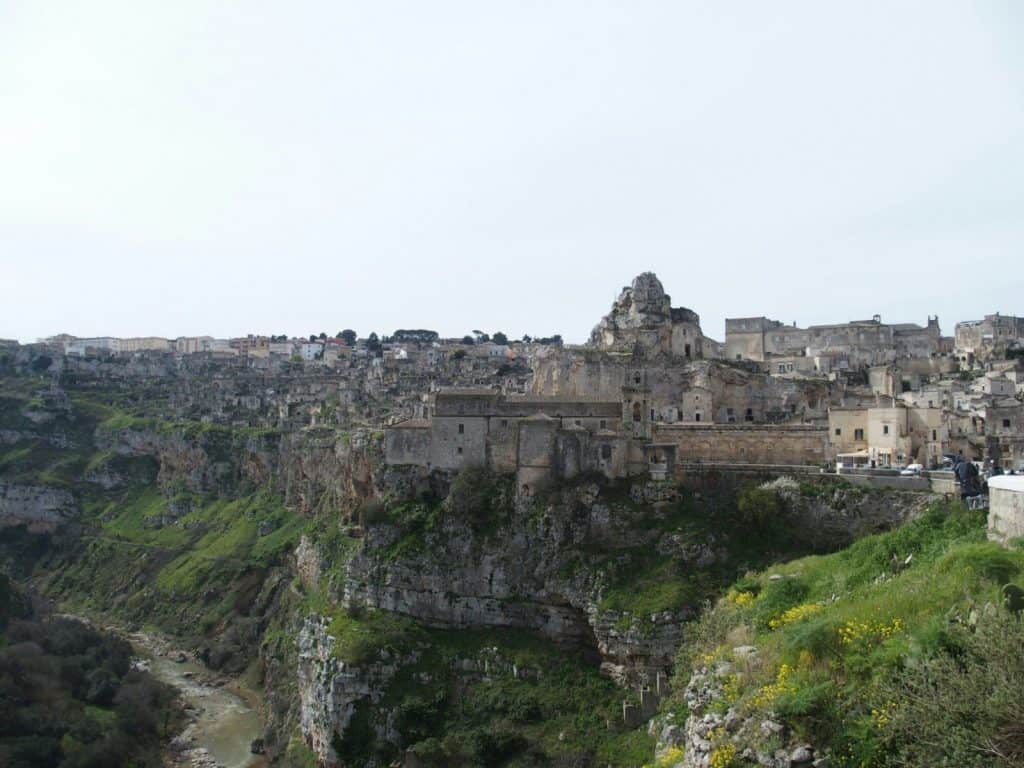Movie buffs might recognize Matera as go-to location for films about the death of Jesus Christ, most recently Mel Gibson’s ‘The Passion of Christ’. And though Christian faith did in fact have great influence on the development of the city, its history spans many more centuries and the region has much more to offer.
Unusual for an ancient city large parts of the old town lie in two adjacent canons. This makes for amazing views upon entering from the new town above.
The reason for this is a large number of natural caves in the calcarenitic rock (also known as tuffo) that attracted humans as early as the Paleolithic Age (which ended 10.000 years ago). Later settlers dug new caves, and those were eventually extended to more conventional houses.
In fact the city is so unique that in 1993 Matera was declared a UNESCO World Heritage Site.
I arrived in the city on the bus from Policoro. Matera is the regional capital and therefore well-serviced by busses. There is even a train from Bari run by the private Ferrovie Appulo Lucane (FAL) railway company. From the bus stop it’s only a short walk to the Sassi.
Sasso means ‘stone’ in the local dialect. It’s easy to see why.
I first descended into the newer part of the old town, Sasso Barisano, and made my way to the oldest quarter, Civita, the area around the duomo, the cathedral. The roads are wider than in the medina of the Middle East. But they are cobbled and connected by a maze of steps, some of which have been hewn into the rock. A visit to Matera is not for you if you aren’t a strong walker.
Behind Civita an unexpected view opened up: a river ravaging in another canon, with green pastures rising to one side and cliffs to the other; somewhere along that valley I could hear the metallic clang of bells used to mark goats. The Murgia Materana is a national park spanning 8,000 hectares. More or less hidden in it are more caves, used as dwellings and churches, and now waiting to be discovered by hikers.
But I didn’t have time to explore. Instead I turned back and into Sasso Caveore. In the older one of the two Sassi a few more houses lie in ruin, there are more churches and more grotti refurbished to let visitors see how people lived here only little more than 50 years ago.
I finished my stroll in Via Domenico Ridola, just outside the Sassi, at the Chiesa del Purgatorio, a baroque church mainly dedicated to death.
Practicalities — Tips about visiting Matera
- Busses run several times daily from and to the larger cities in the area. The bus station is slightly difficult to navigate as there are no signs or schedules or plans.
- From/to Bari there is also the Ferrovie Appulo Lucane (FAL).
- Bus and train stop are close to the Sassi, only a five-minute walk along Via Minzoni / Via Ascanio Persico.
- You can easily get the gist of the Sassi within 3 hours. If you’re backpacking you can drop off your pack at the bus ticket desk (biglietteria) which is about 50 m from the bus station in Via Minzoni for a small fee.
- Nearest airports are Bari and Brindisi.
- There is an official tourist information next to the bus station. But they were neither well staffed nor well stocked (no Matera maps) when I visited. The establishments marked ‘Tourist Information’ in the old town are all companies selling tours and trinkets.
- There is an abundance of sleeping options on the Sassi, mostly in Barisano. For a fancy bed – in a grotto, with direct access to the Murgia – look at the Sextantio Hotel in Cevita. According to booking.com nightly rates per room start at 250 Euro. The cheapest place is the Le Monchelle HI youth hostel next to the duomo, occupying part of an old monastery.
- There are no supermarkets in or near the Sassi. There are plenty of restaurants, but all geared towards tourists and therefore not cheap. For ice cream it’s worth to hike up to Via Domenico Ridola.
- There is a number of festivals, from sculpture to women’s fiction taking place throughout late spring to early autumn in the city. The most important traditional festivity is the Festa della Madonna della Bruna, celebrated annually on 2 July.
- In 2019 Matera will be European City of Culture. So you can get there now before the big rush, or wait until 2019 to see more of the current renovation works finished.
For more photos from my visit to Matera see the full album on Flickr.

